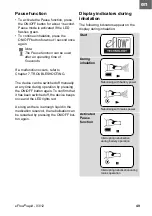
eFlow
®
rapid
- 03/12
55
en
Possible alternative:
Boiling in distilled water
Place the individual parts of your nebuliser
handset (incl. aerosol head) in boiling wa-
ter for at least 5 minutes. Use only distilled
water. Ensure that the water level in the
pot remains high enough to prevent the
nebuliser handset parts from coming into
contact with the hot base of the pot.
Drying, storage, transport
A damp environment encourages the
growth of bacteria. Therefore, remove the
nebuliser handset parts and accessories
from the pan or disinfector as soon as dis-
infection has finished. The risk of infection
is reduced when the parts are dried com-
pletely.
• Place all nebuliser handset parts on a
dry, clean and absorbent surface and al-
low to dry completely (at least 4 hours):
• Between uses, and in particular during
long breaks in treatment, place the neb-
uliser handset in the accompanying
nebuliser bag and keep it in a dry, dust-
free environment (e.g. not in the
bathroom).
• Reassemble the nebuliser handset just
prior to the next treatment. This is to
ensure that the silicone seals do not
become deformed over time.
• For transport, pack the nebuliser hand-
set together with the control unit, power
adapter and connection cord in the trans-
port case provided for this purpose.
Hygienic reprocessing in the
hospital and doctor's practice
When using the eFlow
®
rapid
for several
patients, the nebuliser handset must be
cleaned, disinfected and sterilised before
each change in patient.
Ensure that only adequately validated
device-specific and product-specific proce-
dures are used for cleaning, disinfection and
sterilisation, and that the validated
parameters are observed in each cycle.
The cleaning and disinfection procedure
must be recognised as effective (e.g. in the
list of tested and recognised disinfectants
and procedures issued by the Robert Koch
Institute/DGHM) (Deutsche Gesellschaft für
Hygiene und Mikrobiologie - German socie-
ty for hygiene and microbiology) and al-
ready validated in all cases.
If another procedure is used, its effective-
ness must be confirmed during validation.
CE-approved chemical disinfectants may
also be used, provided they satisfy the
requirements for material resistance.
In addition, follow the hygiene regula-
tions of the hospital or the medical
practice.
Material resistance
The nebuliser handset unit can withstand
temperatures up to 121 °C.
Note the following when selecting cleaners/
disinfectants:
- Essentially, the aldehydic disinfectant
group is suitable for disinfecting this
nebuliser handset (hospital/doctor's
surgery).
- The materials resistance of this nebuliser
handset has not been tested against
other groups of cleaning agents and disin-
fectants.
- When selecting the chemicals to be used,
make sure that they are suitable for clean-
ing and disinfecting medical devices
made from the materials specified in
Note:
Do not dry in damp rooms (e.g. the
bathroom).
Summary of Contents for eflowrapid 178G1005
Page 1: ...Gebrauchsanweisung Instructions for Use nebuliser system...
Page 6: ...2 eFlow rapid 03 12...
Page 38: ...34 eFlow rapid 03 12...
Page 70: ...66 eFlow rapid 03 12...
Page 102: ...98 eFlow rapid 03 12...
Page 134: ...130 eFlow rapid 03 12...
Page 166: ...162 eFlow rapid 03 12...
Page 198: ...194 eFlow rapid 03 12...
Page 230: ...226 eFlow rapid 03 12...
Page 262: ...258 eFlow rapid 03 12...
Page 294: ...290 eFlow rapid 03 12...
Page 329: ......
















































